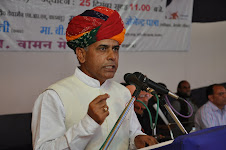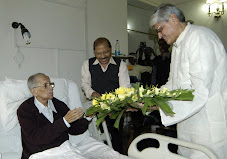Why memories of Gujarat 2002 stay
AJAZ ASHRAF
http://www.thehindu.com/opinion/op-ed/why-memories-of-gujarat-2002-stay/article4570587.ece
Riots under BJP rule are the culmination of the Sangh Parivar's ideological impulse to keep communal tensions alive while for Congress they are tactical instruments
Bharatiya Janata Party (BJP) president Rajnath Singh's decision to accord a prominent role to Gujarat Chief Minister Narendra Modi is presumably based on the belief that the diverse Indian electorate would forgive him for the communal mayhem of 2002, as it often has the Congress for the riots under its rule. This can be presumed from the comments Mr. Singh made at a function in Delhi in early February. In a recriminatory tone, he had then asked, "Our opposition parties allege that BJP is the party which creates enmity between Hindus and Muslims. Did riots not take place during Congress rule?"
Not just the votaries and apologists of the BJP but even ideologically neutral individuals often echo the sentiments Mr. Singh expressed. From Jabalpur (Madhya Pradesh) in 1961 to Bharatpur (Rajasthan) in 2012, the Congress has palpably failed to control communal hotheads from running amok periodically. Yet the party hasn't been tagged communal, and still garners a substantial chunk of the minority as well as secular votes. What explains the dichotomy in the public response to the riots under the BJP rule as compared to those under the Congress governments?
ELEMENTAL
For one, the phenomenon of communal riot is an elemental aspect of the Sangh Parivar's ideology, an extreme manifestation of its politics which is predicated on articulating and redressing the grievances of Hindus, real or imagined, the provenance of which lies either in the medieval past or in post-Independence public policies the saffron brigade perceives as unjustifiably favouring the minorities.
This worldview pits the Hindus against the minorities, particularly the Muslims, until such time the inexhaustible list of grievances is addressed. The politics emanating from this worldview consequently spawns an ambience of tension among communities, reduced or heightened depending on the exigencies of circumstances but never allowed to dissipate. In other words, the inter-community tension, signifying the abnormal in politics, has no possibility of closure in the immediate future. It is designed to become our daily state of existence.
The tension is stoked at pan-India, State and district levels. The Ram Janmabhoomi movement sought to meld the Hindus, with all their class, caste, linguistic and regional divides, into a monolith, through a demand asking Muslims to voluntarily relinquish their custody of the Babri Masjid. Of similar nature are the demands for relocating mosques abutting the Krishna and Shiv temples in Mathura and Varanasi. These symbols of pan-India Hindu mobilisation are augmented through the manufacturing of disputes over places of worship of local significance. Into this category fall the protracted disputes over the Bhagyalakshmi temple at the base of the Charminar in Hyderabad, the Baba Budangiri-Guru Dattatreya shrine in Karnataka, and the Bhojshala complex in Dhar, Madhya Pradesh.
In addition, there are hundreds of places of worship and graveyards in mofussil towns whose ownerships are contended between Hindus and Muslims. No doubt, some of these disputes date back decades but, over the years, myriad groups comprising the Sangh Parivar have taken over the leadership of these 'little battles of liberation'. For variety, Christian priests are attacked and churches vandalised on the charges of converting Hindus to Christianity.
In this culture of inter-community tension, alternatively fanned and allowed to simmer, the riot is the logical culmination of an insidious process. It is akin to a person experiencing a nervous breakdown after suffering acute mental agony for months; it is similar to living life on the edge, uncertain though you are about the precise moment of the inevitable fall off the precipice. Indeed, communal tension in perpetuity is less traumatic only in degrees to an outbreak of a riot.
The sheer salience of tension-riot in the politics of BJP is precisely why a localised inter-community conflict under its rule acquires a resonance countrywide. It is perceived as illustrative of the fate awaiting the minorities in an India in which the BJP exercises untrammeled power. The 2002 riot of Gujarat was horrifying not only because of its barbarity but also because it was viewed to have been ideologically driven and, therefore, bound to be replicated elsewhere.
By contrast, the riots under the Congress rule, even the ones its activists spearhead, are instrumental rather than ideological. Barring the anti-Sikh pogrom of 1984, the riots under the Congress rarely spill beyond a parliamentary constituency or two. The motive behind such mayhem is usually a local Congressman wanting to win an election from a constituency; a riot or communal tension rarely becomes a tool for political mobilisation countrywide, again, the 1984 riots being the exception. Though cynical, the breakdown in inter-community relationship is almost always followed by attempts to restore the earlier social harmony.
ATONEMENT
No doubt, the Congress was justifiably implicated in the 1984 riots. It symbolically atoned for its guilt by appointing Manmohan Singh as Prime Minister, and he, on August 12, 2005, apologised not only to the Sikh community in Parliament, but also to the entire nation "because what took place in 1984 is the negation of the concept of nationhood in our Constitution".
More significantly, the Congress is forgiven because the riots under it are often (not always, though) the handiwork of organisations owing allegiance or belonging to the Sangh Parivar. It's a conclusion several commissions of inquiry appointed to probe riots have reached. There are just too many to be quoted. But sample what the Joseph Vithayathil Commission on the Tellicherry riots of 1971 said. It traced the origin of communal tension in the town to the RSS's decision to establish its units there. In an incident the rioters accosted one Muhammad and offered him the following choice, "If you want to save your life you should go round the house three times repeating the words, 'Rama, Rama'." The commission noted, "Muhammad did that. But you cannot expect the 70 million Muslims of India to do that as a condition for maintaining communal harmony in the country".
More than 40 years after Tellicherry, tension-riot remains the Sangh Parivar's defining strategy of achieving its ideological goal of turning India Hindu. This is why we remember the riots under the BJP and not those under the Congress, which too has been responsible for the spilling of blood and untold misery.
(Ajaz Ashraf is a Delhi-based journalist. E-mail: ashrafajaz3@gmail.com)





































No comments:
Post a Comment